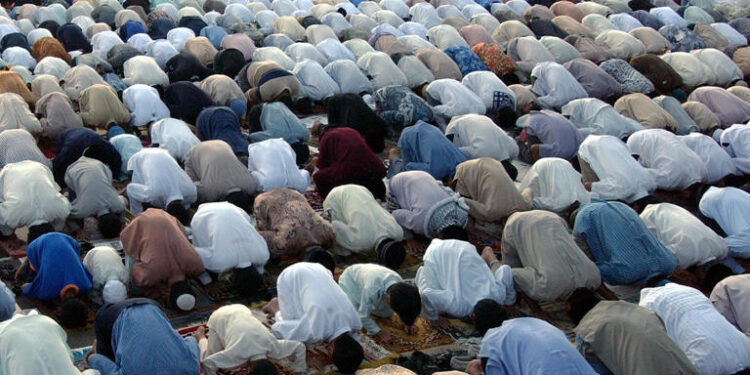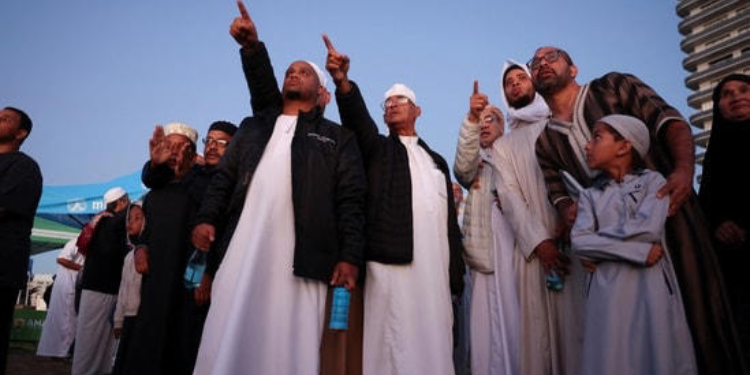Muslims worldwide celebrate Eid-ul-Fitr, also known as the “Festival of Breaking the Fast,” on the first day of the Islamic month of Shawwal, following the sighting of the crescent moon.
As the new moon was not sighted on Monday, April 8, 2024, evening after Maghrib prayers, Muslims in Saudi Arabia and neighboring countries will fast one more day, completing 30 days of Ramadan.
They will then celebrate the first day of Eid on Wednesday, April 10.
All believers of Islam religion observe this day with great enthusiasm as the Muslim community comes together to celebrate and experience peace.
As such, Eid-ul-Fitr signifies the conclusion of Ramadan, a holy month characterized by spiritual reflection.
Throughout the period of Ramadan, Muslims fast daily between sunrise and sunset, a practice of deep significance commemorating the revelation of the Quran to Prophet Muhammad.

Traditionally, Eid spans three days and is observed as an official holiday in Muslim-majority nations, although the duration of the holiday may differ by country.
Also Read: April Fools Day: All You Need to Know, Including History and Origin
How Muslims Celebrate Eid-ul-Fitr
Muslims begin Eid-ul-Fitr day celebrations by partaking in a prayer service shortly after dawn, followed by a short sermon.
Once Eid prayers are finished, Muslims will traditionally visit their relatives and friends to wish them a happy Eid and often exchange gifts or sweets.
Another name for Eid al-Fitr is the Festival of Sweets, reflecting the tradition of indulging in sweet treats during the celebration.
The most commonly used greetings during Eid are “Eid Mubarak” (Blessed Eid) or “Eid sa’id” (Happy Eid), although greetings may vary depending on the country and language.
Muslims are also required to give Zakat al-Fitr, a mandatory charity consisting of food, before the Eid prayer.
Zakat ul-Fitr, also known as the Zakat of Breaking the Fast of Ramadan, is special obligatory alms paid by all Muslims at the conclusion of the fasting month of Ramadan.
This charity, also referred to as Sadaqat al-Fitr or “the Charity of Breaking the Fast” of Ramadan, involves giving a portion of one’s wealth to those in need.
However, Zakat ul-Fitr must be given before the Eid prayer, which is performed in congregation, fostering a sense of family and community spirit.
Also Read: Why China Celebrates New Year in January or February
Why the Dates Keep Changing
The difference between the solar Gregorian calendar and the Islamic Hajri calendar causes the date of Eid al-Fitr to change, as the Islamic calendar is governed by the time the moon takes to go through each of its lunar phases.
This dynamic nature means that the date of Eid ul-Fitr does not remain fixed in the Gregorian calendar.
The reason for this lies in the fact that a solar year comprises 365 days, while a lunar year consists of approximately 354 days.
Consequently, Islamic holidays shift forward by 10 to 11 days each year. In the Islamic calendar, Eid al-Fitr always occurs on the first day of Shawwal, the tenth month.






















































![Senator Allan Chesang And Chanelle Kittony Wed In A Colourful Ceremony [Photos] Trans Nzoia Senator Allan Chesang With Channelle Kittony/Oscar Sudi]( https://thekenyatimescdn-ese7d3e7ghdnbfa9.z01.azurefd.net/prodimages/uploads/2025/11/Trans-Nzoia-Senator-Allan-Chesang-with-Channelle-KittonyOscar-Sudi-360x180.png)




















